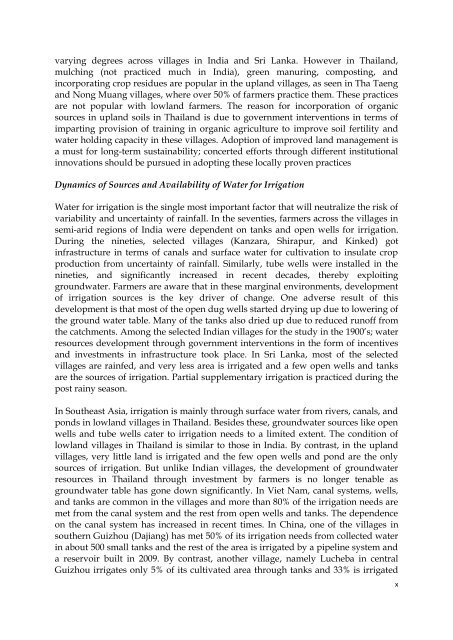Regional synthesis report - icrisat
Regional synthesis report - icrisat
Regional synthesis report - icrisat
Create successful ePaper yourself
Turn your PDF publications into a flip-book with our unique Google optimized e-Paper software.
varying degrees across villages in India and Sri Lanka. However in Thailand,<br />
mulching (not practiced much in India), green manuring, composting, and<br />
incorporating crop residues are popular in the upland villages, as seen in Tha Taeng<br />
and Nong Muang villages, where over 50% of farmers practice them. These practices<br />
are not popular with lowland farmers. The reason for incorporation of organic<br />
sources in upland soils in Thailand is due to government interventions in terms of<br />
imparting provision of training in organic agriculture to improve soil fertility and<br />
water holding capacity in these villages. Adoption of improved land management is<br />
a must for long-term sustainability; concerted efforts through different institutional<br />
innovations should be pursued in adopting these locally proven practices<br />
Dynamics of Sources and Availability of Water for Irrigation<br />
Water for irrigation is the single most important factor that will neutralize the risk of<br />
variability and uncertainty of rainfall. In the seventies, farmers across the villages in<br />
semi-arid regions of India were dependent on tanks and open wells for irrigation.<br />
During the nineties, selected villages (Kanzara, Shirapur, and Kinked) got<br />
infrastructure in terms of canals and surface water for cultivation to insulate crop<br />
production from uncertainty of rainfall. Similarly, tube wells were installed in the<br />
nineties, and significantly increased in recent decades, thereby exploiting<br />
groundwater. Farmers are aware that in these marginal environments, development<br />
of irrigation sources is the key driver of change. One adverse result of this<br />
development is that most of the open dug wells started drying up due to lowering of<br />
the ground water table. Many of the tanks also dried up due to reduced runoff from<br />
the catchments. Among the selected Indian villages for the study in the 1900’s; water<br />
resources development through government interventions in the form of incentives<br />
and investments in infrastructure took place. In Sri Lanka, most of the selected<br />
villages are rainfed, and very less area is irrigated and a few open wells and tanks<br />
are the sources of irrigation. Partial supplementary irrigation is practiced during the<br />
post rainy season.<br />
In Southeast Asia, irrigation is mainly through surface water from rivers, canals, and<br />
ponds in lowland villages in Thailand. Besides these, groundwater sources like open<br />
wells and tube wells cater to irrigation needs to a limited extent. The condition of<br />
lowland villages in Thailand is similar to those in India. By contrast, in the upland<br />
villages, very little land is irrigated and the few open wells and pond are the only<br />
sources of irrigation. But unlike Indian villages, the development of groundwater<br />
resources in Thailand through investment by farmers is no longer tenable as<br />
groundwater table has gone down significantly. In Viet Nam, canal systems, wells,<br />
and tanks are common in the villages and more than 80% of the irrigation needs are<br />
met from the canal system and the rest from open wells and tanks. The dependence<br />
on the canal system has increased in recent times. In China, one of the villages in<br />
southern Guizhou (Dajiang) has met 50% of its irrigation needs from collected water<br />
in about 500 small tanks and the rest of the area is irrigated by a pipeline system and<br />
a reservoir built in 2009. By contrast, another village, namely Lucheba in central<br />
Guizhou irrigates only 5% of its cultivated area through tanks and 33% is irrigated<br />
x

















